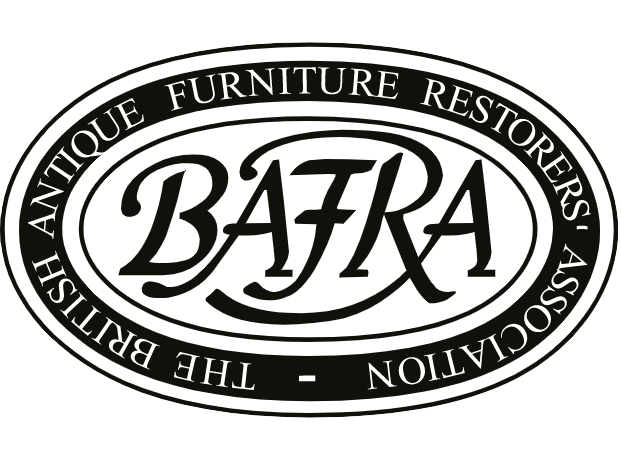
Japanning Restoration & Repair
At BAFRA, we provide access to japanning restoration and repair. Every member has been rigorously assessed and vetted. Our members are all established businesses that are fully accredited and work to the highest standards and ethics.
Japanning Restorers & Conservators at BAFRA
Originating in Japan, this decorative technique involves applying multiple layers of varnish or lacquer infused with pigments to wooden or metal surfaces, creating a glossy, durable finish reminiscent of traditional Japanese lacquerware. Over time, japanned surfaces may suffer from wear, chipping, discolouration, or loss of sheen due to age, exposure to light, or improper handling.
Restoration begins with a thorough assessment of the piece to identify areas of damage or deterioration. BAFRA skilled restorers carefully clean the surface to remove dirt and grime, then address any structural issues such as cracks or chips. Depending on the extent of damage, layers of old varnish or paint may need to be stripped away to reveal the original surface.
Once the surface is prepared, our restoration specialists meticulously apply new layers of varnish or lacquer, tinted to match the original colour and sheen. Intricate designs or motifs are meticulously hand-painted or stencilled onto the surface to recreate the intricate patterns characteristic of japanning.
The final steps involve curing and polishing the restored surface to achieve a flawless finish that recaptures the beauty and elegance of the original japanned piece. Through japanning restoration at BAFRA, cherished antiques and decorative objects can be rejuvenated, ensuring their continued appreciation for generations to come.
Japanning Restoration FAQs
What is Japanning?
Japanning is a type of imitation of East Asian lacquer finish that emerged as a finish in the 17th century. It was first used on furniture but was also later used on small metal items. It is also often called toleware. Japanning is typically a heavy black lacquer finish, almost like enamel paint, although it can also come in reds, greens and blues. It traditionally uses gold designs and pictures to contrast with the black base colour.
What types of surfaces can be japanned?
Japanning can be applied to various surfaces, including wood, metal, and papier-mâché. It is commonly found on antique furniture, decorative objects, and architectural elements. The versatility of japanning allows it to adorn a wide range of surfaces, providing a durable and decorative finish that enhances the beauty and longevity of objects in both functional and ornamental contexts.
What is japanning restoration?
Japanning restoration is a meticulous process aimed at rejuvenating the glossy, decorative finish characteristic of japanned surfaces. This technique involves applying layers of varnish or lacquer infused with pigments to wooden or metal surfaces, creating a durable and lustrous finish. Through japanning restoration, cherished antiques and decorative objects are revived to their former elegance.
Why might Japanning require restoration?
Japanning may require restoration due to issues like chipping, cracking, discolouration, or loss of sheen over time. Multilayered coatings are often more vulnerable to damage, combined with the combination of a variety of materials which can accelerate the deterioration process. Damage caused by changes in environmental conditions can also play a factor. Exposure to light, moisture, or improper handling can also contribute to deterioration. Restoration revives the original beauty and integrity of japanned surfaces, ensuring their continued appreciation.
What restoration techniques are used in japanning restoration?
Japanning restoration involves a variety of techniques to revive the glossy finish and intricate designs of japanned surfaces. These may include cleaning the surface, stripping away old varnish or paint layers, repairing structural damage, applying new layers of varnish or lacquer, and meticulously hand-painting or stencilling intricate designs. Our restorers combine traditional methods with modern restoration techniques to ensure that the japanned surface is restored to its original beauty and durability.
Can japanning restoration increase the value of antique objects?
Yes, japanning restoration can increase the value of antique objects by restoring their aesthetic appeal and historical significance. Professional restoration performed with skill and respect for the original craftsmanship enhances the visual appeal and integrity of japanned surfaces. This can make antique objects more desirable to collectors and enthusiasts, potentially increasing their market value. However, the impact on value may vary depending on factors such as the rarity, provenance, and condition of the piece.
Why choose a BAFRA-accredited member to restore antique Japanning?
The importance of having japanning restored by a BAFRA-accredited qualified craftsman cannot be stressed enough. There is considerable experience required behind the approach to every japanning restoration job, and particular expertise is required. There are restorers and conservators available to provide a full range of antique japanning restoration services. BAFRA members have in-depth knowledge based on more than 20 years of experience restoring, repairing and conserving antique japanning.
Find BAFRA Accredited Japanning Restoration & Repair Specialists
All accredited, full members are required to have at least five years as a conservation-restoration professional (the average member today has 23 years of experience) and pass an exacting assessment on their skills, knowledge and business credentials. Our members acknowledge the importance of continuous professional development to keep abreast of advances in knowledge, skills and technical developments in Japanning.
Find BAFRA-accredited japanning restoration specialists near you by clicking the button below and entering your postcode.

